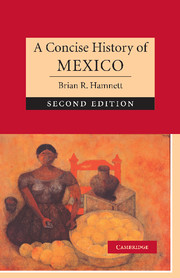Book contents
- Frontmatter
- Contents
- List of illustrations
- Chronology
- Preface to the second edition
- Preface to the first edition
- 1 Mexico in perspective
- 2 The pre-Columbian era
- 3 The European incursion, 1519–1620
- 4 New Spain, 1620–1770: Spanish colonialism and American society
- 5 Destabilisation and fragmentation, 1770–1867
- 6 Reconstruction, 1867–1940
- 7 The monopoly party, 1940–2000
- 8 The Fox administration, 2000–2006
- 9 Cultural developments since Independence
- Final comments
- Bibliography
- Index
- Titles in the series
Preface to the second edition
Published online by Cambridge University Press: 05 June 2014
- Frontmatter
- Contents
- List of illustrations
- Chronology
- Preface to the second edition
- Preface to the first edition
- 1 Mexico in perspective
- 2 The pre-Columbian era
- 3 The European incursion, 1519–1620
- 4 New Spain, 1620–1770: Spanish colonialism and American society
- 5 Destabilisation and fragmentation, 1770–1867
- 6 Reconstruction, 1867–1940
- 7 The monopoly party, 1940–2000
- 8 The Fox administration, 2000–2006
- 9 Cultural developments since Independence
- Final comments
- Bibliography
- Index
- Titles in the series
Summary
In the years since the publication of the first edition, Mexican studies have continued to expand, as the additions to the bibliography clearly demonstrate. Mexico entered a new phase in its history, when in the presidential elections of July 2000, the electorate voted the Partido Revolucionario Institucional (PRI) out of power. Mexicans asked themselves in 2000 whether their country had finally become a working democracy, in which opposition parties gained national power and the institutions of federalism functioned effectively. High expectations of a reforming presidency gradually petered out in the subsequent years amid charges of empty rhetoric, unfulfilled promises and political confusion. I have included a brief analysis of the Fox Presidency of 2000–06 in a new Chapter 8. Since I am a historian and not a ‘political scientist’, I make no predictions about either forthcoming election results or future developments in the country.
This second edition retains the structure, periodisation and themes of the first. However, I have amended certain sections, particularly in Chapter 2, in the light of further reading, and corrected a factual error in Chapter 4, which should never have appeared in the first place. At the same time, I have removed several comments on the events of the later 1990s in Chapter 7, which seemed to be important at the time but which now do not. In retrospect, the first edition seemed to lean too far in the direction of economic and political analysis.
- Type
- Chapter
- Information
- A Concise History of Mexico , pp. xviii - xixPublisher: Cambridge University PressPrint publication year: 2006

